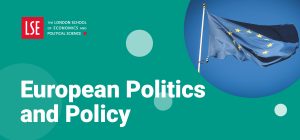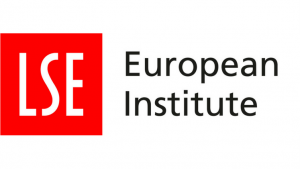EUROPP is running a series of articles on the European Parliament elections, which were held on 22-25 May. This page collates all of the material in the series. The first section on the page gives an overview of how the elections work, the Chart in the second section shows the number of seats each parliamentary group received in the elections, while the country tabs in the third section illustrate the number of seats each national party received. The final section contains a number of articles on the campaign at the European level.
[separator top=”40″ style=”none”][title size=”2″]How European Parliament Elections Work[/title]
[accordian]
[toggle title=”The Elections” open=”no”]Elections will be held in each of the 28 EU member states on 22-25 May to elect the Members of the European Parliament (MEPs) who will represent European citizens during the next parliamentary term: from July 2014 until the next European Parliament elections in 2019. The date of the election in each state varies, largely because different countries have traditions of voting on different days of the week. The elections are therefore spread out over four days.
Number of MEPs
The total number of MEPs has been reduced for the 2014 elections from 766 to 751. This reduction is to comply with a limit placed on the size of the Parliament by the Treaty of Lisbon.
Distribution of seats
Seats in the European Parliament are allocated to each state on the basis of population, with the largest states being assigned the most MEPs. For the 2014 elections, the distribution of seats is as follows:

Electoral systems
It is up to each state to choose how they elect their allocated MEPs, but there are some broad rules about the kind of systems which may be used. The system must be generally proportional (the overall percentage of votes must loosely match the percentage of seats given to each party) and electoral thresholds to determine which parties are eligible for a share of seats must not be set any higher than five per cent of the vote.
Most countries use a form of party list proportional representation, of which there are essentially two different types. Under the first system, termed a ‘closed list’ system, voters simply vote for a party of their choice. Seats are then distributed to parties based on the percentage of the vote they receive: for instance, if there are 10 seats available and five parties each gain 20 per cent of the vote, then all five parties will receive two seats each. Under a closed list system, the politicians who receive these seats are determined by a list of candidates which is put forward by each party in advance. If a party wins one seat then it will be given to the candidate at the top of the list, if they win two seats then the next seat will go to the second candidate on the list, and so on. Countries which use closed list systems include France, Germany, Portugal, Spain and the UK (excluding Northern Ireland).
The second form of party list proportional representation, in contrast, allows voters to vote not just for a party, but also to influence the order of the party lists by indicating a preference for individual candidates. In this system, sometimes called ‘preferential voting’ or a ‘semi-open list’, seats are distributed to parties based on the overall vote share they receive, but within party lists those candidates with the highest support are put to the top of the list (although there are variations in how this works in practice). Preferential voting is used in Austria, Belgium, Croatia, Denmark, Finland, Greece, the Netherlands and Sweden, among others. Luxembourg essentially uses an ‘open list’ system as voters can ‘cross-vote’: i.e. they can vote for multiple candidates across different party lists.
In two states, Ireland and Malta, plus the region of Northern Ireland in the UK, a different system is used entirely: the Single Transferable Vote (STV). In this system, voters rank candidates in order of preference, typically by putting the number 1 next to their first choice, 2 next to their second choice and so on. The basic principle for allocating seats under this system is that candidates must reach a certain quota to be elected (e.g. if there is only one seat being contested in a constituency then the quota might be 50 per cent of the vote). If no candidate reaches this quota (or in the case of multiple seats within a constituency, not enough candidates to allocate all of the seats available) then candidates with the least votes are ‘eliminated’ and the voters who supported these candidates have their vote ‘transferred’ to their second preference. This continues until all of the seats have been allocated.
There are also variations in the types of constituency used in European elections. Five states – France, Ireland, Italy, Poland and the UK – separate their elections into different regions (e.g. there are 8 MEPs allocated to London, so the seats for London are distributed based on the percentage of the vote each party receives from London voters). Most countries, however, treat the entire country as a single constituency. The electoral system used in each country is shown below.
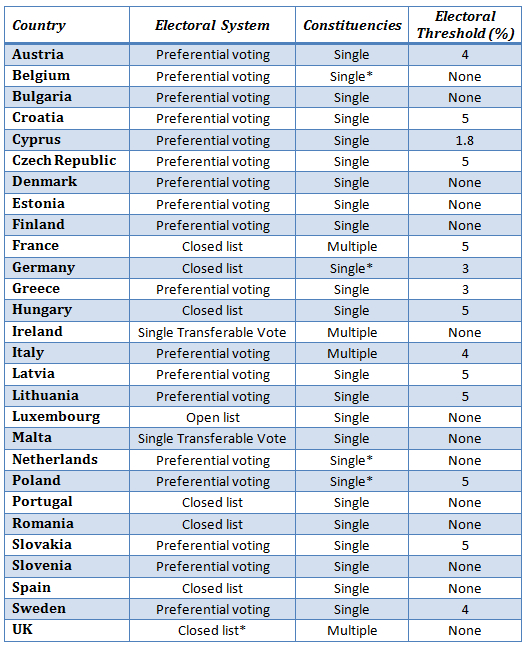
Note: Although Germany originally had a three per cent threshold, this was invalidated by the German Constitutional Court so no threshold was in place for the 2014 elections. The UK uses a closed list system except in Northern Ireland, which uses Single Transferable Vote. Belgium, Germany, the Netherlands and Poland are treated as single constituencies, but there are particular rules in which regions play a role in the distribution of seats (for instance in Belgium there is a single seat reserved for the country’s German speaking minority).
[/toggle]
[toggle title=”Political groups in the European Parliament” open=”no”]Although all MEPs are elected nationally and therefore usually represent a national political party, most MEPs sit within European political groups in the Parliament itself. These groups are generally associated with the European political party that each national party is a member of. For instance, Angela Merkel’s Christian Democratic Union (CDU) party is also a member of the European People’s Party. In the European Parliament CDU MEPs therefore sit in the corresponding European People’s Party political group. This adds an element of cohesion to voting within the Parliament as it would be exceptionally difficult to co-ordinate votes between a wide collection of political parties from across 28 states. There are seven main political groups in the current parliament (shown below) and an additional 32 MEPs who are not associated with any group.
[one_half last=”no”][content_boxes layout=”icon-with-title” iconcolor=”” circlecolor=”” circlebordercolor=”” backgroundcolor=””]
[content_box title=”The Group of the European People’s Party” icon=”” image=”https://blogs.lse.ac.uk/europpblog/files/2014/04/EPPlogo.png” image_width=”44″ image_height=”44″ link=”http://www.epp.eu/” linktarget=”” linktext=”EPP website” animation_type=”” animation_direction=”” animation_speed=””]The political group of the European People’s Party (EPP) contains the majority of MEPs from centre-right and Christian democratic parties. It is currently the largest political group in the 2009-14 European Parliament with 274 MEPs. Some of the larger national political parties affiliated to the group are Angela Merkel’s Christian Democratic Union (CDU) in Germany; the largest mainstream centre-right party in France, the Union for a Popular Movement (UMP); and Mariano Rajoy’s People’s Party in Spain. [/content_box] [/one_half]
[one_half last=”yes”][content_boxes layout=”icon-with-title” iconcolor=”” circlecolor=”” circlebordercolor=”” backgroundcolor=””]
[content_box title=”Progressive Alliance of Socialists and Democrats” icon=”” image=”https://blogs.lse.ac.uk/europpblog/files/2014/04/sanddlogo.gif” image_width=”44″ image_height=”44″ link=”http://www.socialistsanddemocrats.eu/” linktarget=”” linktext=”S&D website” animation_type=”” animation_direction=”” animation_speed=””]The Progressive Alliance of Socialists and Democrats (S&D) group is composed largely of centre-left parties and is affiliated to the Party of European Socialists. It is the second largest group in the current parliament with 195 MEPs. The national parties included in the S&D group include the UK’s Labour Party; the Social Democratic Party of Germany (SPD); Matteo Renzi’s Democratic Party (PD) in Italy; the Spanish Socialist Workers’ Party (PSOE) in Spain; and François Hollande’s Socialist Party (PS) in France.[/content_box][/one_half]
[one_half last=”no”][content_boxes layout=”icon-with-title” iconcolor=”” circlecolor=”” circlebordercolor=”” backgroundcolor=””]
[content_box title=”Alliance of Liberals and Democrats for Europe Group” icon=”” image=”https://blogs.lse.ac.uk/europpblog/files/2014/04/ALDElogo.jpeg” image_width=”44″ image_height=”44″ link=”http://www.alde.eu/” linktarget=”” linktext=”ALDE website” animation_type=”” animation_direction=”” animation_speed=””]The Alliance of Liberals and Democrats for Europe Group (ALDE/ADLE) brings together MEPs from centrist and liberal parties. It is affiliated to the Alliance of Liberals and Democrats for Europe Party and currently has 84 MEPs in the Parliament. Some of the national political parties affiliated to the group include the UK’s Liberal Democrats; the People’s Party for Freedom and Democracy (VVD) in the Netherlands; the Free Democratic Party (FDP) in Germany; and the National Liberal Party (PNL) in Romania.[/content_box] [/one_half]
[one_half last=”yes”][content_boxes layout=”icon-with-title” iconcolor=”” circlecolor=”” circlebordercolor=”” backgroundcolor=””]
[content_box title=”The Greens/European Free Alliance Group” icon=”” image=”https://blogs.lse.ac.uk/europpblog/files/2014/04/greensefalogo.jpg” image_width=”44″ image_height=”44″ link=”http://www.greens-efa.eu/” linktarget=”” linktext=”Greens/EFA website” animation_type=”” animation_direction=”” animation_speed=””]The Greens/European Free Alliance (Greens/EFA) group is composed mainly of MEPs from green and regionalist parties. It is affiliated to two European parties, the European Green Party and the European Free Alliance, and currently has 58 MEPs. Some of the larger national parties in this group are Europe Ecology – The Greens in France; Alliance ’90/The Greens in Germany; GreenLeft (GroenLinks) in the Netherlands; and the Scottish National Party (SNP) and Green Party of England and Wales in the UK. [/content_box][/one_half]
[one_half last=”no”][content_boxes layout=”icon-with-title” iconcolor=”” circlecolor=”” circlebordercolor=”” backgroundcolor=””]
[content_box title=”The European Conservatives and Reformists Group” icon=”” image=”https://blogs.lse.ac.uk/europpblog/files/2014/04/ecrlogo.jpeg” image_width=”44″ image_height=”44″ link=”http://ecrgroup.eu/” linktarget=”” linktext=”ECR website” animation_type=”” animation_direction=”” animation_speed=””]The European Conservatives and Reformists (ECR) Group comprises MEPs from conservative, anti-federalist, and broadly Eurosceptic parties. It currently has 57 MEPs and is affiliated to two European political parties, the Alliance of European Conservatives and Reformists, and the European Christian Political Movement. The three largest national parties in the ECR group are the UK’s Conservative Party; the Civic Democratic Party (ODS) in the Czech Republic; and Law and Justice (PiS) in Poland.[/content_box] [/one_half]
[one_half last=”yes”][content_boxes layout=”icon-with-title” iconcolor=”” circlecolor=”” circlebordercolor=”” backgroundcolor=””]
[content_box title=”European United Left/Nordic Green Left Group” icon=”” image=”https://blogs.lse.ac.uk/europpblog/files/2014/04/guenglogo.jpg” image_width=”44″ image_height=”44″ link=”http://www.guengl.eu/” linktarget=”” linktext=”GUE/NGL website” animation_type=”” animation_direction=”” animation_speed=””]The European United Left/Nordic Green Left (GUE/NGL) group is made up of MEPs from generally left-wing, socialist and communist parties. It currently has 35 MEPs and is affiliated to two European political parties, the Party of the European Left and the European Anti-Capitalist Left. Germany’s Die Linke (The Left) has the most MEPs of the national parties associated with GUE/NGL, while the Communist Party of Bohemia and Moravia (KSČM) in the Czech Republic, and Alexis Tsipras’ SYRIZA in Greece are also part of this group.[/content_box][/one_half]
[one_half last=”no”][content_boxes layout=”icon-with-title” iconcolor=”” circlecolor=”” circlebordercolor=”” backgroundcolor=””]
[content_box title=”The Europe of Freedom and Democracy Group” icon=”” image=”https://blogs.lse.ac.uk/europpblog/files/2014/04/efdlogo.jpg” image_width=”44″ image_height=”44″ link=”http://www.efdgroup.eu/” linktarget=”” linktext=”EFD website” animation_type=”” animation_direction=”” animation_speed=””]The Europe of Freedom and Democracy (EFD) group is made up primarily of Eurosceptic MEPs who oppose European integration or their country’s membership of the European Union. It has 31 MEPs in the current parliament, with some EFD parties belonging to either the European Alliance for Freedom, or the Movement for a Europe of Liberties and Democracy European party. The two largest national parties in the group are the United Kingdom Independence Party (UKIP) and the Northern League (Lega Nord) in Italy.[/content_box] [/one_half]
[one_half last=”yes”][content_boxes layout=”icon-with-title” iconcolor=”” circlecolor=”” circlebordercolor=”” backgroundcolor=””]
[content_box title=”” icon=”” image=”” image_width=”” image_height=”” link=”” linktarget=”” linktext=”S&D website” animation_type=”” animation_direction=”” animation_speed=””][/content_box][/one_half]
[/toggle]
[toggle title=”Candidates for President of the European Commission” open=”no”]In addition to electing MEPs in the Parliament, the 2014 elections will also play a large role in determining who will be the next President of the European Commission. The next Commission President will be determined by a vote in the European Parliament on the basis of a proposal made by the national governments of EU member states in the European Council. Although there is still some doubt over how this process will work in practice, it is anticipated that the President of the Commission will therefore come from one of the European political parties which secures success in the European Parliament elections. For the first time, European political parties have therefore put forward official candidates for the Commission President. The six candidates announced so far are shown below.
[one_half last=”no”][content_boxes layout=”icon-with-title” iconcolor=”” circlecolor=”” circlebordercolor=”” backgroundcolor=””]
[content_box title=”Jean-Claude Juncker – European People’s Party” icon=”” image=”https://blogs.lse.ac.uk/europpblog/files/2014/04/juncker.jpg” image_width=”80″ image_height=”108″ link=”” linktarget=”” linktext=”” animation_type=”” animation_direction=”” animation_speed=””]Jean-Claude Juncker was selected by the European People’s Party as their candidate for Commission President at the EPP congress in Dublin on 6-7 March. Juncker was the Prime Minister of Luxembourg from 1995 until December 2013 and is a member of Luxembourg’s Christian Social People’s Party.[/content_box] [/one_half]
[one_half last=”yes”][content_boxes layout=”icon-with-title” iconcolor=”” circlecolor=”” circlebordercolor=”” backgroundcolor=””]
[content_box title=”Martin Schulz – Party of European Socialists” icon=”” image=”https://blogs.lse.ac.uk/europpblog/files/2014/04/schultz-smile.jpg” image_width=”80″ image_height=”108″ link=”” linktarget=”” linktext=”” animation_type=”” animation_direction=”” animation_speed=””]Martin Schulz was formally selected as the candidate for the Party of European Socialists in March 2014. He was originally elected as an MEP for the Social Democratic Party of Germany (SPD) and is currently the President of the European Parliament. Prior to this he was the President of the Progressive Alliance of Socialists and Democrats.[/content_box] [/one_half]
[one_half last=”no”][content_boxes layout=”icon-with-title” iconcolor=”” circlecolor=”” circlebordercolor=”” backgroundcolor=””]
[content_box title=”Guy Verhofstadt – Alliance of Liberals and Democrats for Europe” icon=”” image=”https://blogs.lse.ac.uk/europpblog/files/2014/04/guyverhofthumbnail.jpg” image_width=”80″ image_height=”108″ link=”” linktarget=”” linktext=”” animation_type=”” animation_direction=”” animation_speed=””]Guy Verhofstadt is the candidate for the Alliance of Liberals and Democrats for Europe. He was the Prime Minister of Belgium between 1999 and 2008, before being elected as an MEP in 2009. Since 2009 he has also served as the leader of the Alliance of Liberals and Democrats for Europe.[/content_box] [/one_half]
[one_half last=”yes”][content_boxes layout=”icon-with-title” iconcolor=”” circlecolor=”” circlebordercolor=”” backgroundcolor=””]
[content_box title=”Ska Keller / José Bové – European Green Party” icon=”” image=”https://blogs.lse.ac.uk/europpblog/files/2014/04/skabove.jpg” image_width=”142″ image_height=”108″ link=”” linktarget=”” linktext=”” animation_type=”” animation_direction=”” animation_speed=””]The European Green Party selected two candidates for Commission President using a primary system. Ska Keller is a German MEP for Alliance ’90/The Greens, while José Bové is a French MEP who was elected on the Europe Écologie coalition in 2009 and previously stood as a candidate for French President in the 2007 presidential election.[/content_box] [/one_half]
[one_half last=”no”][content_boxes layout=”icon-with-title” iconcolor=”” circlecolor=”” circlebordercolor=”” backgroundcolor=””]
[content_box title=”Alexis Tsipras – Party of the European Left” icon=”” image=”https://blogs.lse.ac.uk/europpblog/files/2014/04/AlexisTsiprasprofile.jpg” image_width=”80″ image_height=”108″ link=”” linktarget=”” linktext=”” animation_type=”” animation_direction=”” animation_speed=””]The Party of the European Left selected Alexis Tsipras as their candidate. Tsipras is the leader of the Coalition of the Radical Left (usually referred to as SYRIZA) in Greece, which became the second largest party and main opposition in the Greek parliament in the general elections held in 2012.[/content_box] [/one_half]
[one_half last=”yes”][content_boxes layout=”icon-with-title” iconcolor=”” circlecolor=”” circlebordercolor=”” backgroundcolor=””]
[content_box title=”Peter Sunde / Amelia Andersdotter – European Pirates” icon=”” image=”https://blogs.lse.ac.uk/europpblog/files/2014/04/piratepair.jpg” image_width=”178″ image_height=”108″ link=”” linktarget=”” linktext=”” animation_type=”” animation_direction=”” animation_speed=””]The European Pirates have also selected two candidates. Peter Sunde is a co-founder and ex-spokesperson for the Pirate Bay website. He is not currently an MEP, but is standing as a candidate in the 2014 elections for the Pirate Party of Finland. Amelia Andersdotter is currently an MEP for the Swedish Pirate Party.[/content_box][/one_half]
[/toggle]
[/accordian]
[separator top=”40″ style=”none”][title size=”2″]Provisional Results[/title]
For more information on the groups in the Parliament, see: European United Left–Nordic Green Left (GUE-NGL); Progressive Alliance of Socialists and Democrats (S&D); The Greens–European Free Alliance (Greens/EFA); Alliance of Liberals and Democrats for Europe (ALDE); European People’s Party (EPP); European Conservatives and Reformists (ECR); Europe of Freedom and Democracy (EFD).
[separator top=”40″ style=”none”] [title size=”2″]Country Polls and Previews[/title]
[fusion_tabs layout=”vertical” backgroundcolor=”” inactivecolor=””]
[fusion_tab title=”Austria”]

Latest update: Average of EP polls between 14 – 17 May; Gallup, Hajek, Market and Unique. For more information on the parties see: Social Democratic Party of Austria (SPÖ), Freedom Party of Austria (FPÖ), Austrian People’s Party (ÖVP), The Greens – The Green Alternative, NEOS – The New Austria.
[recent_posts columns=”3″ number_posts=”3″ offset=”” cat_slug=”Austria-European-Parliament-Elections” thumbnail=”yes” title=”yes” meta=”yes” excerpt=”no” excerpt_words=”15″][/recent_posts][/fusion_tab]
[fusion_tab title=”Belgium”]

Latest update: average of polls between 28 April – 11 May; RTBF. Note: The Christian Social Party (CSP) represents Belgium’s German speaking community – under Belgian law one seat is reserved for this community. For more information on the other parties see: New-Flemish Alliance (N-VA); Christian Democratic and Flemish (CD&V); Socialist Party (PS); Reformist Movement (MR); Open Flemish Liberals and Democrats (Open Vld); Socialist Party Different (sp.a); Humanist Democratic Centre (cdH); Groen (Green); Ecolo; Flemish Interest (VB); Workers’ Party of Belgium (PTB); People’s Party (PP); Francophone Democratic Federalists (FDF).
[recent_posts columns=”3″ number_posts=”3″ offset=”” cat_slug=”Belgium-European-Parliament-Elections” thumbnail=”yes” title=”yes” meta=”yes” excerpt=”no” excerpt_words=”15″][/recent_posts][/fusion_tab]
[fusion_tab title=”Bulgaria”]
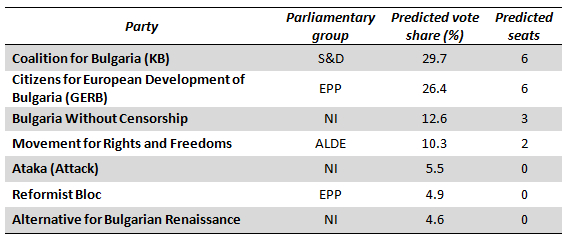
Latest update: average of polls 13 May; Media and IMP. Note: The Coalition for Bulgaria is an alliance between several parties: the Bulgarian Socialist Party (BSP), Party of Bulgarian Social Democrats, Agrarian Union “Aleksandar Stamboliyski”, and Movement for Social Humanism. For more information on the other parties see: Citizens for European Development of Bulgaria (GERB); Bulgaria Without Censorship; Movement for Rights and Freedoms; Alternative for Bulgarian Renaissance; Reformist Bloc; Ataka (Attack).
[recent_posts columns=”3″ number_posts=”3″ offset=”” cat_slug=”Bulgaria-European-Parliament-Elections” thumbnail=”yes” title=”yes” meta=”yes” excerpt=”no” excerpt_words=”15″][/recent_posts][/fusion_tab]
[fusion_tab title=”Croatia”]

Latest update: EP poll conducted by Ipsos Puls 16 May. Note: The Croatian Democratic Union Coalition is composed of four parties, of which the Croatian Democratic Union is the largest. The Kukuriku Coalition contains parties from different parliamentary groups, as a result the vote share shown is for the coalition as a whole, but the seat prediction is split between the parties in each group: the Social Democratic Party of Croatia, which is part of S&D; and the Croatian People’s Party – Liberal Democrats (HNS) and Istrian Democratic Assembly (IDS-DDI), which are part of ALDE. For information on the other parties, see: Croatian Sustainable Development (ORaH); Croatian Labourists – Labour Party; and Alliance for Croatia, which is an alliance of several small right-wing parties.
[recent_posts columns=”3″ number_posts=”3″ offset=”” cat_slug=”Denmarky-European-Parliament-Elections” thumbnail=”yes” title=”yes” meta=”yes” excerpt=”no” excerpt_words=”15″][/recent_posts][/fusion_tab]
[fusion_tab title=”Cyprus”]

Latest update: EP poll conducted by IMR on 15 May. Note: Several parties are running in coalitions. For more information on the parties, see: Democratic Rally (DISY); Progressive Party of Working People (AKEL); Democratic Party (DIKO); and Movement for Social Democracy EDEK.
[recent_posts columns=”3″ number_posts=”3″ offset=”” cat_slug=”Denmarky-European-Parliament-Elections” thumbnail=”yes” title=”yes” meta=”yes” excerpt=”no” excerpt_words=”15″][/recent_posts][/fusion_tab]
[fusion_tab title=”Czech Republic”]
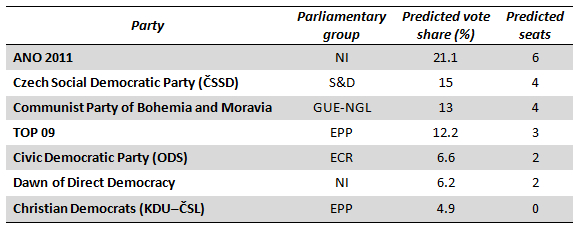
Latest update: average of EP polls conducted from 20 April – 16 May by Herzmann and Sanep. For more information on the parties see: ANO 2011; Czech Social Democratic Party (ČSSD); Communist Party of Bohemia and Moravia (KSČM); TOP 09; Civic Democratic Party (ODS); Christian Democrats (KDU-ČSL); and Dawn of Direct Democracy.
[recent_posts columns=”3″ number_posts=”3″ offset=”” cat_slug=”Czech-European-Parliament-Elections” thumbnail=”yes” title=”yes” meta=”yes” excerpt=”no” excerpt_words=”15″][/recent_posts][/fusion_tab]
[fusion_tab title=”Denmark”]
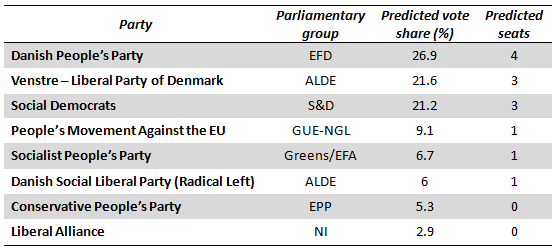
Latest update: Average of polls 6 – 12 May; YouGov, Epinion, Greens, Gallup, A&B, and Voxmeter. For more information on parties see: Venstre – Liberal Party of Denmark; Danish People’s Party; Social Democrats; People’s Movement Against the EU; Danish Social Liberal Party (Radical Left); Socialist People’s Party; Conservative People’s Party; Liberal Alliance.
[recent_posts columns=”3″ number_posts=”3″ offset=”” cat_slug=”Denmark-European-Parliament-Elections” thumbnail=”yes” title=”yes” meta=”yes” excerpt=”no” excerpt_words=”15″][/recent_posts][/fusion_tab]
[fusion_tab title=”Estonia”]

Latest update: average of EP polls from 16 April – 17 May; TNS Emor. Note: Indrek Tarand is an independent candidate. For more information on the parties see: Estonian Centre Party; Social Democratic Party; Estonian Reform Party; Union of Pro Patria and Res Publica.
[recent_posts columns=”3″ number_posts=”3″ offset=”” cat_slug=”Denmarky-European-Parliament-Elections” thumbnail=”yes” title=”yes” meta=”yes” excerpt=”no” excerpt_words=”15″][/recent_posts][/fusion_tab]
[fusion_tab title=”Finland”]
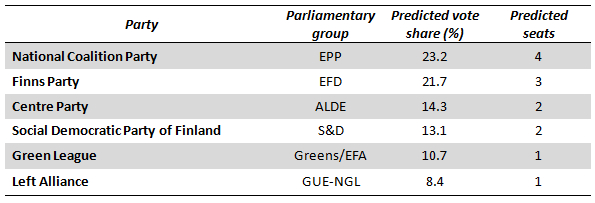
Latest update: average of EP polls from 20 March – 6 May; YouGov and YLE. For more information on the parties see: National Coalition Party; Centre Party; Finns Party; Social Democratic Party of Finland; Green League; Left Alliance.
[recent_posts columns=”3″ number_posts=”3″ offset=”” cat_slug=”Finland-European-Parliament-Elections” thumbnail=”yes” title=”yes” meta=”yes” excerpt=”no” excerpt_words=”15″][/recent_posts][/fusion_tab]
[fusion_tab title=”France”]
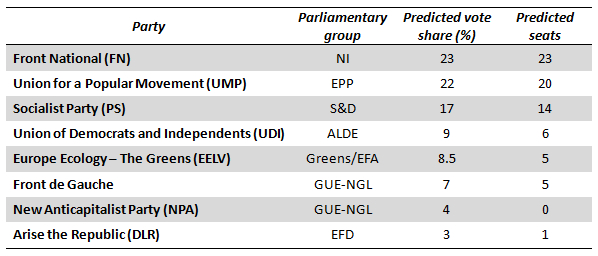
Latest update: average of EP polls from 14 – 16 May; Ifop, OpinionWay, TNS, CSA and Ipsos. For more information on the parties see: Union for a Popular Movement (UMP); Front National (FN); Socialist Party (PS); Front de Gauche; Union of Democrats and Independents (UDI); Europe Ecology – The Greens (EELV); New Anticapitalist Party (NPA); Arise the Republic (DLR).
[recent_posts columns=”3″ number_posts=”3″ offset=”” cat_slug=”France-European-Parliament-Elections” thumbnail=”yes” title=”yes” meta=”yes” excerpt=”no” excerpt_words=”15″][/recent_posts][/fusion_tab]
[fusion_tab title=”Germany”]

Latest update: average of EP polls from 8 – 16 May; FGW and Infratest. For more information on the parties see: Christian Democrats (CDU/CSU); Social Democrats (SPD); German Greens; Die Linke (The Left); Alternative for Germany (AfD); Free Democrats (FDP); Pirate Party; National Democratic Party of Germany (NPD); Free Voters (FW).
[recent_posts columns=”3″ number_posts=”3″ offset=”” cat_slug=”Germany-European-Parliament-Elections” thumbnail=”yes” title=”yes” meta=”yes” excerpt=”no” excerpt_words=”15″][/recent_posts][/fusion_tab]
[fusion_tab title=”Greece”]
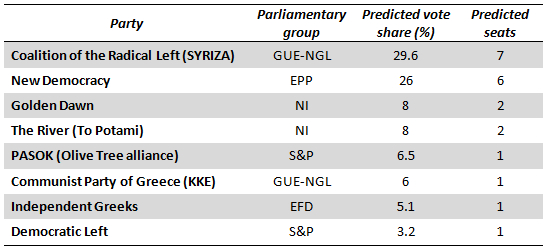
Latest update: average of EP polls from 14 – 15 May; Palmos and Alco. Note: PASOK is contesting the elections as part of the ‘Olive Tree’ alliance, which also includes Agreement for the New Greece, Dynamic Greece and the New Reformers. For information on the other parties see: Coalition of the; Radical Left (SYRIZA); New Democracy; Golden Dawn; The River (To Potami); Communist Party of Greece (KKE); Independent Greeks; Democratic Left.
[recent_posts columns=”3″ number_posts=”3″ offset=”” cat_slug=”Greece-European-Parliament-Elections” thumbnail=”yes” title=”yes” meta=”yes” excerpt=”no” excerpt_words=”15″][/recent_posts][/fusion_tab]
[fusion_tab title=”Hungary”]
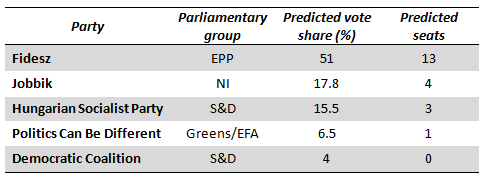
Latest update: average of EP polls from 13-16 May; IPSOS and Nezopont Intezet. Note: Fidesz and the Christian Democratic People’s Party (KDNP) form an alliance. For the other parties see: Hungarian Socialist Party (MSZP); Democratic Coalition (DK); Jobbik; Politics can be Different (LMP).
[recent_posts columns=”3″ number_posts=”3″ offset=”” cat_slug=”Denmarky-European-Parliament-Elections” thumbnail=”yes” title=”yes” meta=”yes” excerpt=”no” excerpt_words=”15″][/recent_posts][/fusion_tab]
[fusion_tab title=”Ireland”]
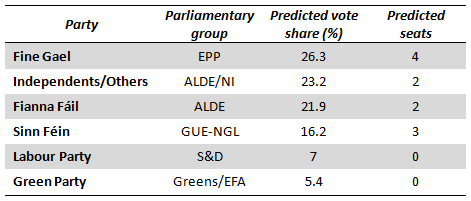
Latest update: average of EP polls from 2 – 14 May; RedC, Millward Brown, and Behaviour & Attitudes. Note: for ‘Independents/Others’ one of the predicted seats will go to a candidate in ALDE and the other is predicted to go to a non-aligned candidate. For information on the parties see: Fine Gael; Fianna Fáil; Sinn Féin; Labour Party; Green Party.
[recent_posts columns=”3″ number_posts=”3″ offset=”” cat_slug=”Ireland-European-Parliament-Elections” thumbnail=”yes” title=”yes” meta=”yes” excerpt=”no” excerpt_words=”15″][/recent_posts][/fusion_tab]
[fusion_tab title=”Italy”]
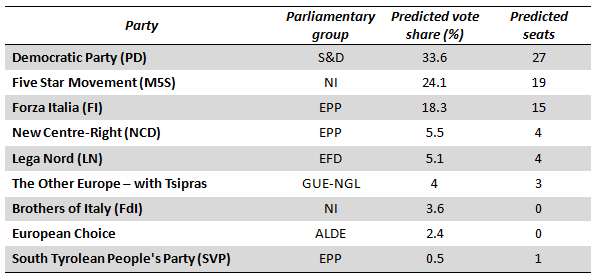
Latest update: average of EP polls from 8 – 9 May; SWG, IXE and DEMOS. For more information on the parties see: Democratic Party (PD); Five Star Movement (M5S); Forza Italia (FI); New Centre-Right (NCD); Lega Nord (LN); The Other Europe – with Tsipras; Brothers of Italy (FdI); European Choice; South Tyrolean People’s Party (SVP). European Choice is an electoral list centred around the Civic Choice party.
[recent_posts columns=”3″ number_posts=”3″ offset=”” cat_slug=”Italy-European-Parliament-Elections” thumbnail=”yes” title=”yes” meta=”yes” excerpt=”no” excerpt_words=”15″][/recent_posts][/fusion_tab]
[fusion_tab title=”Latvia”]

Latest update: EP poll from 28 April; Faktu. Note: Harmony Centre is an alliance of two parties – the Socialist Party of Latvia (GUE-NGL – 2 seats) and the Social Democratic Party (S&D – 1 seat). For more information on the parties see: Harmony Centre, Unity, Union of Greens and Farmers (ZZS), National Alliance (NA), From the Heart of Latvia.
[recent_posts columns=”3″ number_posts=”3″ offset=”” cat_slug=”Latvia-European-Parliament-Elections” thumbnail=”yes” title=”yes” meta=”yes” excerpt=”no” excerpt_words=”15″][/recent_posts][/fusion_tab]
[fusion_tab title=”Lithuania”]
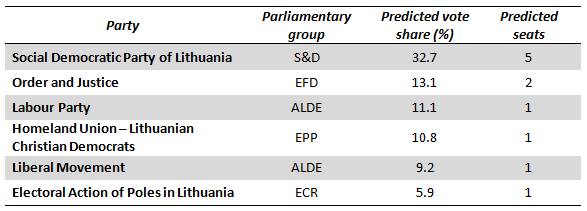
Latest update: average of EP polls from 17 April; Splinter. For more information on the parties see: Social Democratic Party of Lithuania; Order and Justice; Labour Party; Homeland Union – Lithuanian Christian Democrats; Liberal Movement; Electoral Action of Poles in Lithuania.
[recent_posts columns=”3″ number_posts=”3″ offset=”” cat_slug=”Denmarky-European-Parliament-Elections” thumbnail=”yes” title=”yes” meta=”yes” excerpt=”no” excerpt_words=”15″][/recent_posts][/fusion_tab]
[fusion_tab title=”Luxembourg”]

Latest update: based on analysis of general election results in October 2013. For more information on the parties see: Christian Social People’s Party (CSV); Luxembourg Socialist Workers’ Party (LSAP); Democratic Party (DP); The Greens.
[recent_posts columns=”3″ number_posts=”3″ offset=”” cat_slug=”Luxembourg-European-Parliament-Elections” thumbnail=”yes” title=”yes” meta=”yes” excerpt=”no” excerpt_words=”15″][/recent_posts][/fusion_tab]
[fusion_tab title=”Malta”]

Latest update: based on EP poll conducted on 13 April by Malta Today. For more information on the parties see: Labour Party; Nationalist Party; Democratic Alternative.
[recent_posts columns=”3″ number_posts=”3″ offset=”” cat_slug=”Denmarky-European-Parliament-Elections” thumbnail=”yes” title=”yes” meta=”yes” excerpt=”no” excerpt_words=”15″][/recent_posts][/fusion_tab]
[fusion_tab title=”Netherlands”]
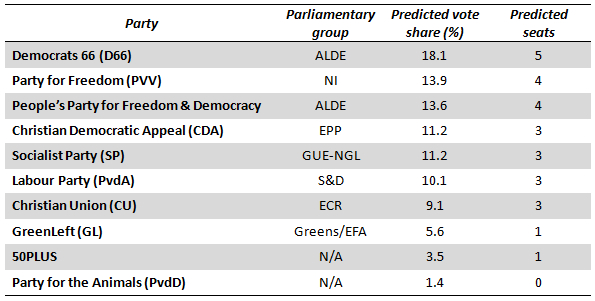
Latest update: average of EP polls from 16 April – 16 May; TNS Nipo. For more information on the parties see: Democrats 66 (D66); Party for Freedom (PVV); People’s Party for Freedom & Democracy ; Christian Democratic Appeal (CDA); Socialist Party (SP); Labour Party (PvdA); Christian Union (CU); GreenLeft (GL); 50PLUS; Party for the Animals (PvdD).
[recent_posts columns=”3″ number_posts=”3″ offset=”” cat_slug=”Netherlands-European-Parliament-Elections” thumbnail=”yes” title=”yes” meta=”yes” excerpt=”no” excerpt_words=”15″][/recent_posts][/fusion_tab]
[fusion_tab title=”Poland”]
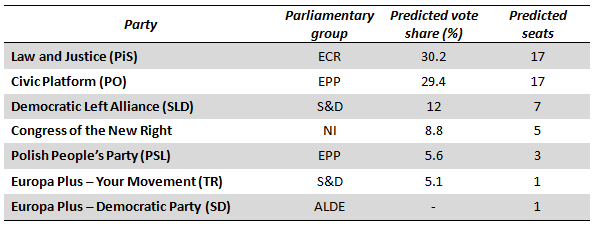
Latest update: average of EP polls from 7 – 14 May; TNS, HH, PPW, and CBOS. Note: Europa Plus is a joint list comprising several parties: the total predicted vote share for the list is shown under “Europa Plus – Your Movement” while the seats for individual parties within this list are also shown. For more information on the other parties see: Law and Justice (PiS); Civic Platform (PO); Democratic Left Alliance (SLD); Congress of the New Right; Polish People’s Party (PSL); Europa Plus – Your Movement.
[recent_posts columns=”3″ number_posts=”3″ offset=”” cat_slug=”Poland-European-Parliament-Elections” thumbnail=”yes” title=”yes” meta=”yes” excerpt=”no” excerpt_words=”15″][/recent_posts][/fusion_tab]
[fusion_tab title=”Portugal”]

Latest update: based on EP poll conducted on 17 May by Aximage. Democratic Unitarian Coalition is an alliance between the Portuguese Communist Party and the Ecologist Party (the Greens). For more information on the other parties, see: Socialist Party; Social Democratic Party; Left Bloc.
[recent_posts columns=”3″ number_posts=”3″ offset=”” cat_slug=”Denmarky-European-Parliament-Elections” thumbnail=”yes” title=”yes” meta=”yes” excerpt=”no” excerpt_words=”15″][/recent_posts][/fusion_tab]
[fusion_tab title=”Romania”]

Latest update: average of EP polls from 10 – 12 May; INSCOP and CSOP. Note: Social Democratic Union (USD) is an alliance of the Social Democratic Party (PSD), the Conservative Party (PC), and the National Union for the Progress of Romania (UNPR). For more information on the other parties see: National Liberal Party (PNL); Democratic Liberal Party (PD-L); Democratic Union of Hungarians in Romania (UDMR); Civic Force (FC); People’s Party – Dan Diaconescu (PP-DD).
[recent_posts columns=”3″ number_posts=”3″ offset=”” cat_slug=”Romania-European-Parliament-Elections” thumbnail=”yes” title=”yes” meta=”yes” excerpt=”no” excerpt_words=”15″][/recent_posts][/fusion_tab]
[fusion_tab title=”Slovakia”]
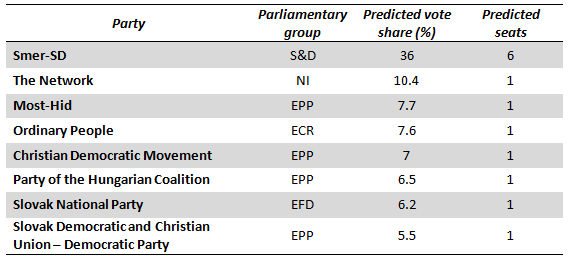
Latest update: average of national polls from 5 May; Polis. Note: The Network is a new party created by Radoslav Procházka. For more information on the other parties, see: Smer-SD; Most-Hid; Ordinary People; Christian Democratic Movement; Party of the Hungarian Coalition; Slovak National Party; Slovak Democratic and Christian Union – Democratic Party.
[recent_posts columns=”3″ number_posts=”3″ offset=”” cat_slug=”Denmarky-European-Parliament-Elections” thumbnail=”yes” title=”yes” meta=”yes” excerpt=”no” excerpt_words=”15″][/recent_posts][/fusion_tab]
[fusion_tab title=”Slovenia”]
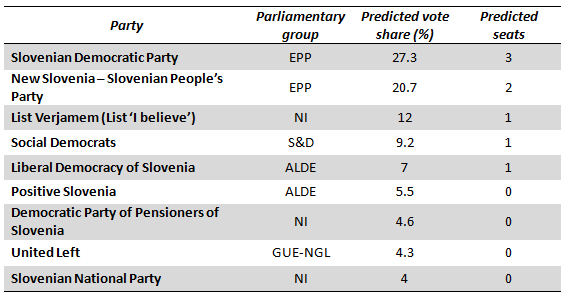
Latest update: average of EP polls from 10 – 13 May; Ninamedia and Episcenter. For more information on the parties see: Slovenian Democratic Party; New Slovenia – Slovenian People’s Party; Social Democrats; Liberal Democracy of Slovenia; Positive Slovenia; Democratic Party of Pensioners of Slovenia; United Left; Slovenian National Party.
[recent_posts columns=”3″ number_posts=”3″ offset=”” cat_slug=”Denmarky-European-Parliament-Elections” thumbnail=”yes” title=”yes” meta=”yes” excerpt=”no” excerpt_words=”15″][/recent_posts][/fusion_tab]
[fusion_tab title=”Spain”]
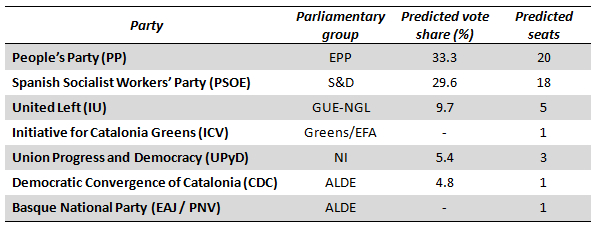
Latest update: average of EP polls from 11 – 19 May; Metroscopia, SigmaDos, Celeste-Tel, and GAD3. Note: United Left and Initiative for Catalonia Greens are running on a joint list and therefore have a joint-vote share shown. A similar format is used for Democratic Convergence of Catalonia and the Basque National Party. For more information on the other parties see: People’s Party (PP); Spanish Socialist Workers’ Party (PSOE); Union, Progress and Democracy (UPyD).
[recent_posts columns=”3″ number_posts=”3″ offset=”” cat_slug=”Spain-European-Parliament-Elections” thumbnail=”yes” title=”yes” meta=”yes” excerpt=”no” excerpt_words=”15″][/recent_posts][/fusion_tab]
[fusion_tab title=”Sweden”]
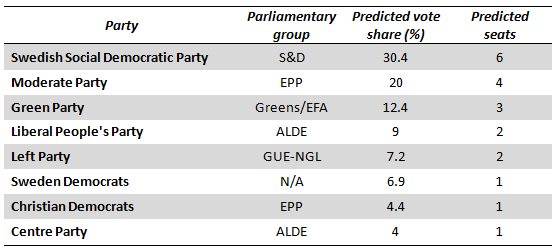
Latest update: average of EP polls from 6 – 12 May; YouGov, Ipsos, Demoskop, and SKOP. For more information on the parties see: Swedish Social Democratic Party; Moderate Party; Green Party; Liberal People’s Party; Left Party; Sweden Democrats; Christian Democrats; Centre Party.
[recent_posts columns=”3″ number_posts=”3″ offset=”” cat_slug=”Sweden-European-Parliament-Elections” thumbnail=”yes” title=”yes” meta=”yes” excerpt=”no” excerpt_words=”15″][/recent_posts][/fusion_tab]
[fusion_tab title=”UK”]

Latest update: average of EP polls from 15 – 18 May; YouGov, ComRes, and ICM. Note: alternative calculations used for Scotland, Northern Ireland and Wales. For more information on the parties see: UK Independence Party (UKIP); Labour Party; Conservative and Unionist Party; Liberal Democrats; Green Party; Scottish National Party (SNP); Democratic Unionist Party; Sinn Féin; Plaid Cymru – Party of Wales; Ulster Unionist Party.
[recent_posts columns=”3″ number_posts=”3″ offset=”” cat_slug=”UK-European-Parliament-Elections” thumbnail=”yes” title=”yes” meta=”yes” excerpt=”no” excerpt_words=”15″][/recent_posts][/fusion_tab]
[/fusion_tabs]
[separator top=”40″ style=”none”] [title size=”2″]European Level Coverage[/title] [recent_posts columns=”3″ number_posts=”15″ offset=”” cat_slug=”european-parliament-elections-2″ thumbnail=”yes” title=”yes” meta=”yes” excerpt=”no” excerpt_words=”15″][/recent_posts]



